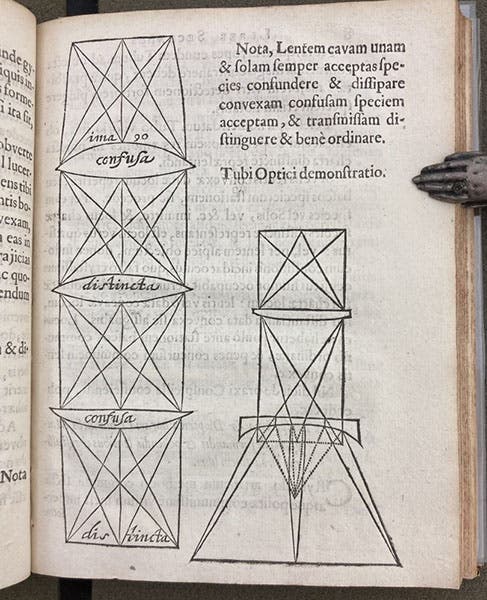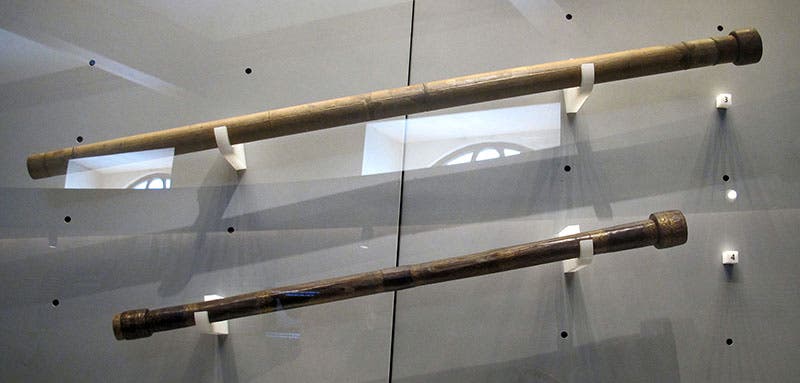Scientist of the Day - Hans Lipperhey
Hans Lipperhey, a German/Dutch lens grinder and eyeglass maker, was buried Sep. 29, 1619, in Middelburg in the Netherlands. We know little about Lipperhey except that, on Oct. 2, 1608, he applied for a patent for an instrument that made far-away things look nearby, or, as we would now call such a device, a telescope. He had discovered that if you take two eyeglass lenses, either two convex lenses or one convex and one concave (we are not sure which he used in his patent application), and space them properly, you can magnify distant objects when you look through them both. HIs patent application was the first written record of a telescope. The application was not successful, because several weeks later, another inventor, Jacob Metius, submitted a similar application, and the States General discovered upon further investigation that many other lens makers, including Zacharias Jensen, claimed to have invented it as well. But Lipperhey was the first to apply for patent recognition.
There are several ways you can combine two eyeglass lenses to make a magnifying instrument. One way is to use two convex lenses, in which case you will get a magnified but inverted image. The other is to use a convex lens at the far end and a concave lens for an eyepiece. This will produce a magnified but upright image. We don't know which instrument was described in the patent, but since Galileo's instrument, built a year later, had a concave eyepiece, it is probable that Lipperhey's had one as well. The fact that later instruments with concave eyepieces were called "Dutch perspective glasses" would seem to confirm this.
Lipperhey's perspective tube might have had a magnification power of three, which is not much, but enough to set other instrument makets to work, once they heard about the invention, which was around November of 1608. We know of instruments built early in 1609, and Thomas Hariot in England was using a telescope of his own making by summer of 1609. We think Hariot's instrument was about six-power. Shortly thereafter, Galileo was constructing instruments of nine-power, which he used in his first observations of the moon in November of 1609. With the publication of Galileo's Siderius nuncius in March of 1610, the telescope as an astronomical instrument had truly arrived.
There are no surviving telescopes by Lipperhey, Jensen, Metius or any of the early constructors. The oldest instruments we have are two by Galileo, which are essentially empty tubes, since the lenses were broken long ago. But they are original, and you may see them on display in the Museo Galileo in Florence, a must-see museum in this city of must-see museums (third image).
Lipperhey's claim to have invented the telescope came to public attention when Pierre Borel published a book, De vero telescopii inventore, in 1656, in which he gave credit for the telescope's invention to Lipperhey and Jensen (although Borel opted for Jensen as the earlier inventor and Lipperhey for the “second inventor”). Borel also provided a crude diagram of a Dutch telescope, the one on the right in the second image. The most surprising feature of Borel's book is that he included engraved portraits of both Lipperhey and Jensen. Where he found portraits of the two eyeglass makers is anyone’s guess, since artisans did not customarily leave life portraits behind, so it is possible these likenesses came out of thin air. But there is nothing wrong with showing the engraving, since it is a historical artifact in its own right, and it does have Lipperhey's name at the bottom. Our copy of Borel’s book is missing both the portraits, which is unfortunate. But it came to the Library a long time ago, before we adopted a policy of never buying rare books that are incomplete. We show you the portrait from another copy (first image).
Dr. William B. Ashworth, Jr., Consultant for the History of Science, Linda Hall Library and Associate Professor emeritus, Department of History, University of Missouri-Kansas City. Comments or corrections are welcome; please direct to ashworthw@umkc.edu.

![Portrait of Hans Lipperhey, engraving, in Pierre Borel, <i>De vero telescopii inventore</i>, 1655 [1656] (Wikimedia commons)](https://assets-us-01.kc-usercontent.com:443/9dd25524-761a-000d-d79f-86a5086d4774/fbfa59a4-431c-4a00-859f-a8c19fffd0f5/lipperhey1.jpg?w=438&h=477&auto=format&q=75&fit=crop)


![Titlepage of Pierre Borel, De vero telescopii inventore, 1655 [1656] (Linda Hall Library)](https://assets-us-01.kc-usercontent.com:443/9dd25524-761a-000d-d79f-86a5086d4774/d1968438-decd-4a01-b4fe-d710188e4937/lipperhey4.jpg?w=460&h=600&auto=format&q=75&fit=crop)




